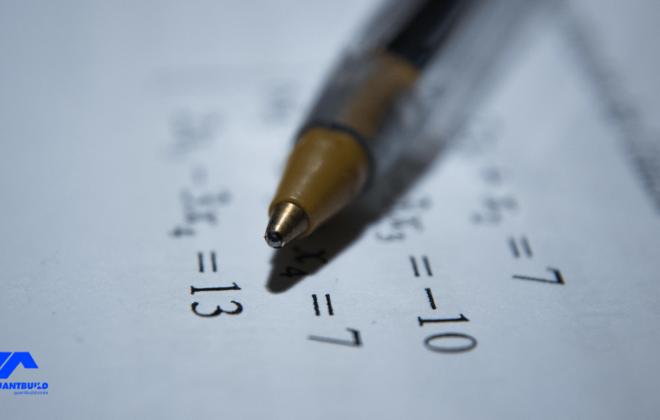The Traditional Method of Preparing Bills of Quantities
The traditional process of preparing bills of quantities can conveniently be broken down into two main processes. These are ‘taking off’ and ‘working up’. It officially starts when the quantity surveyor receives drawings from the architect and engineers and serialises them ready to start extracting building quantities from them.
In this case, the term “quantities” refers to the amounts of the different types of work fixed in a position which collectively gives the total requirements of the building contract.
This can be the volume of concrete in a column, the area covered by roofing sheets or the weight of steel reinforcement bars in a concrete suspended slab.
Taking-off
Taking off is the process in which dimensions are scaled or read from drawings and entered in a recognised form on specially ruled paper, called the dimensions paper.
The dimensions are entered in the order of length, width, and height.
A dimension sheet is divided into two faces, with each face further divided into four columns representing the timesing, dimensions, squaring and descriptions operations. Dimensions read from drawings are recorded in the dimension column.
Read more on the dimension paper in this article.
Working Up
The next step, after recording measurements in the dimension’s column, is working up. This comprises squaring the dimensions and transferring the resultant lengths, areas and volumes to the abstract, then billing.
Let’s look at the squaring, abstracting and billing operations in more detail below.
Squaring
The squaring operation involves multiplying the values in the timesing column with the values in the dimension’s columns, or only the value in the dimension’s column depending on the specific entries in the dimensions paper.
Subsequently, the resultant lengths, areas and volumes are recorded in the third column of the dimension paper. They are now ready to be transferred to the abstract.
In summary, squaring dimensions refers to the calculation of the numbers, lengths, areas and volumes and their entry in the third column of the dimension paper.
Abstracting
Abstracting refers to the process of transferring the squared dimensions to the abstract paper. Here, they are written in a recognised order, ready for billing.
Similar work items are grouped under the appropriate work section headings. Further, they are totalled and reduced to the recognised units of billing. This is a preparatory activity awaiting transferring the quantities to the draft bill.
Draft and Final Billing
In a bill of quantities, the various work items which together form the complete building are listed under the appropriate work section headings. Their corresponding descriptions are written in full and quantities are given in the recognised units of measurement, as laid down in the SMM.
Before that, the quantities are set down in a standard form on a “billing paper”. This billing paper is ruled in columns, so that each work item may be conveniently detailed with a description of the work, the quantity involved and a suitable reference.
The billing paper also contains columns in which a contractor tendering for a particular project enters the rates and prices for each work item. These prices are added together to give the tender sum/contract sum.
The bills of quantities set down the various items of work in a logical sequence and recognised manner, so that they may be readily priced by the contractors.
A contractor will build up in detail a price for each work item contained in the bill of quantities. The price or unit rate is comprised of the cost of the necessary labour, materials and plant, together with the probable wastage on materials and generally a percentage to cover establishment charges, profits and overheads.
Direct Billing
Also, to speed up the working-up process, a method called direct billing was introduced. This method involves transferring the items direct from the dimension sheet to the final bill. It eliminates the need for abstracting.
Therefore, time and money are saved. The resources that would have been used to do the abstracting are channelled to other steps of the process.
It is very suitable where the number of similar items in a project is limited and work is not very complex in character.
Some Basic Measurement Principles
While following this method of a bill of quantities preparation as discussed and described above, there are basic measurement principles that must be observed. These are prescribed in the standard method of measurement.
The following are some of these principles:
- Bills of quantities shall fully describe and accurately represent the quantity and quality of the works to be carried out. Where more detailed information than this is required by these rules, it shall be given to defining the precise nature and extent of the required work.
- The billed descriptions are to be reasonably comprehensive and sufficient to enable the estimator fully understand what is required and to give a realistic price.
- All quantities must be accurate as the information available permits, as inaccurate bills cause major problems.
- All work whose extent cannot be determined with a reasonable degree of accuracy should be described as approximate quantities, and items if this kins should be kept separate from those which contain accurate quantities. In this way, the contractor is made aware of the uncertain nature of the quantity entered and that it will be subject to remeasurement on completion and valuation at billed rates. This can apply to any work where the architect is unable to give full details at the time of measurement.
- Billed items are generally deemed to include (without the need for the specific mention) labour, materials, goods and plant, including all associated costs such as assembling, fitting and fixing, waste of materials, square cutting; establishment and overhead charges and profit.
Reference Books
If you want to learn more about quantity surveying work, here’s my list of recommended essential books that you should read:
- Quantity Surveyor’s Pocket Book – by Duncan Cartlidge
- Building Quantities Explained – by Ivor H. Seeley and Roger Winfield
- Civil Engineering Quantities – by Ivor H. Seeley
- Building Cost Planning for the Design Team – by Jim Smith and David Jaggar.
In Conclusion
The traditional method of preparing bills of quantities starts with taking of quantities from drawings. This is followed by squaring the dimensions and transferring the resultant values to an abstract paper.
The quantities in the abstract are grouped and converted to the relevant billing units. In some cases, this abstracting step can be skipped and quantities from the dimension paper transferred directly to a draft bill.
Whatever the case, care must be exercised to ensure that the bill of quantities produced is very accurate and complete. This will prevent contractual problems and disputes from arising in the future as the project gets built.
Nzangi Muimi
I’m a Quantity Surveyor, Educator and the founder of QuantBuild Academy, the fastest-growing technology-focused YouTube channel online. I am passionate about construction information technology and the digitalization of the construction industry.
Tags In
Related Posts
Leave a Reply Cancel reply
Search
Popular Categories
- ARCHICAD Tutorials (4)
- Construction (17)
- Construction IT (14)
- Construction Law (4)
- Cost Management (15)
- Tutorials (5)





